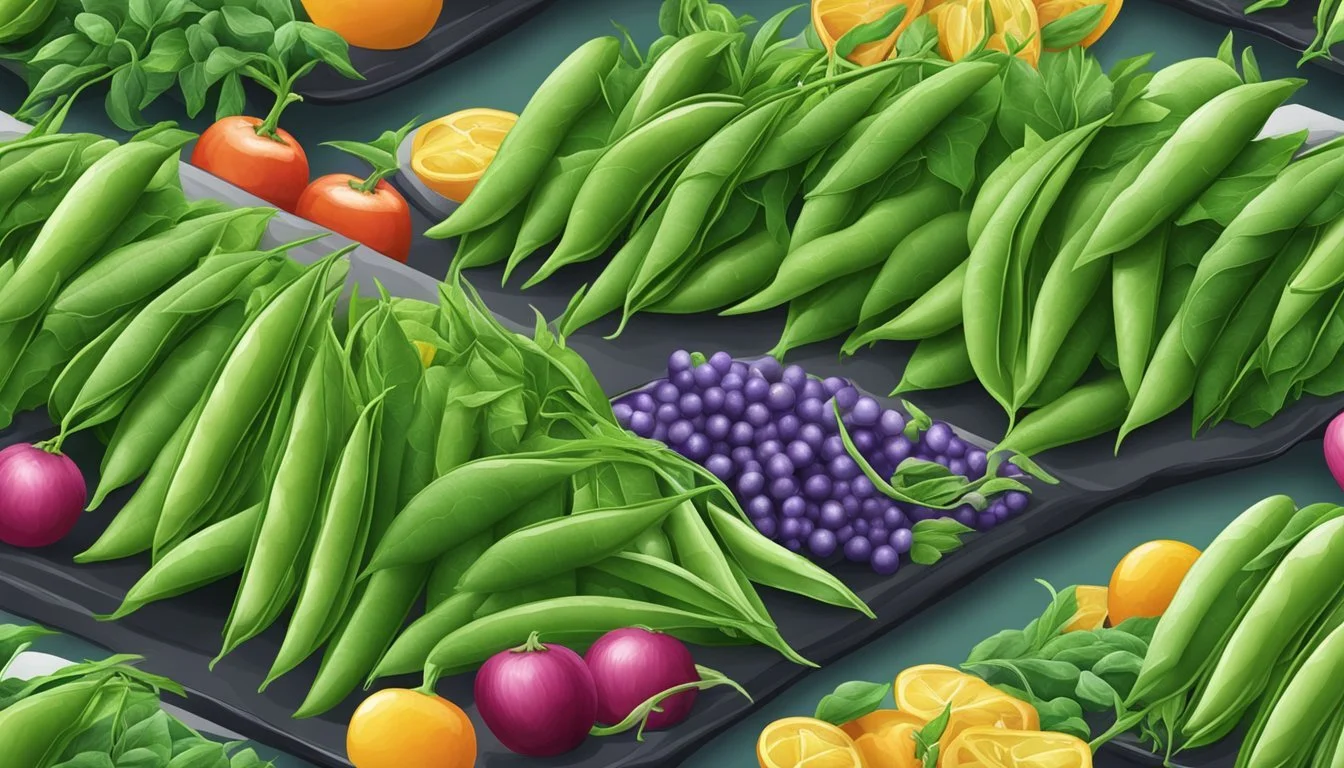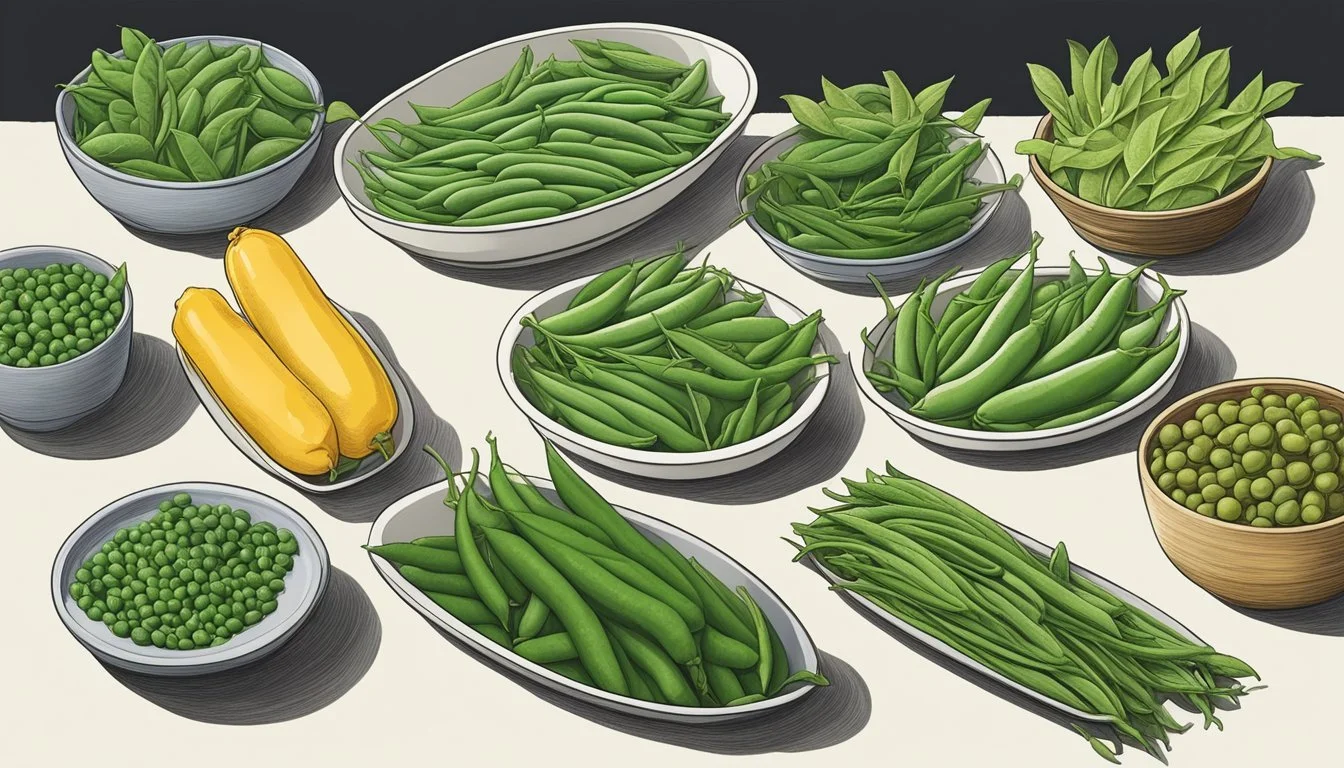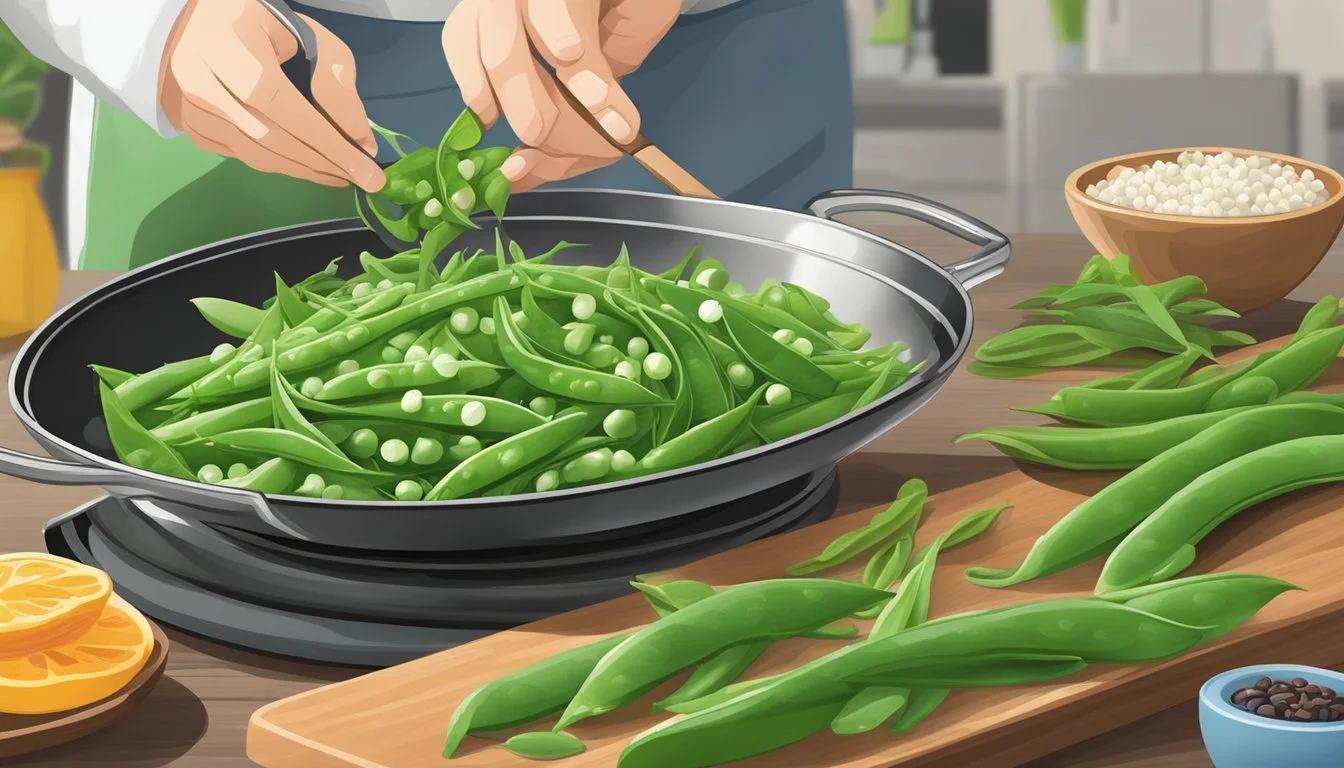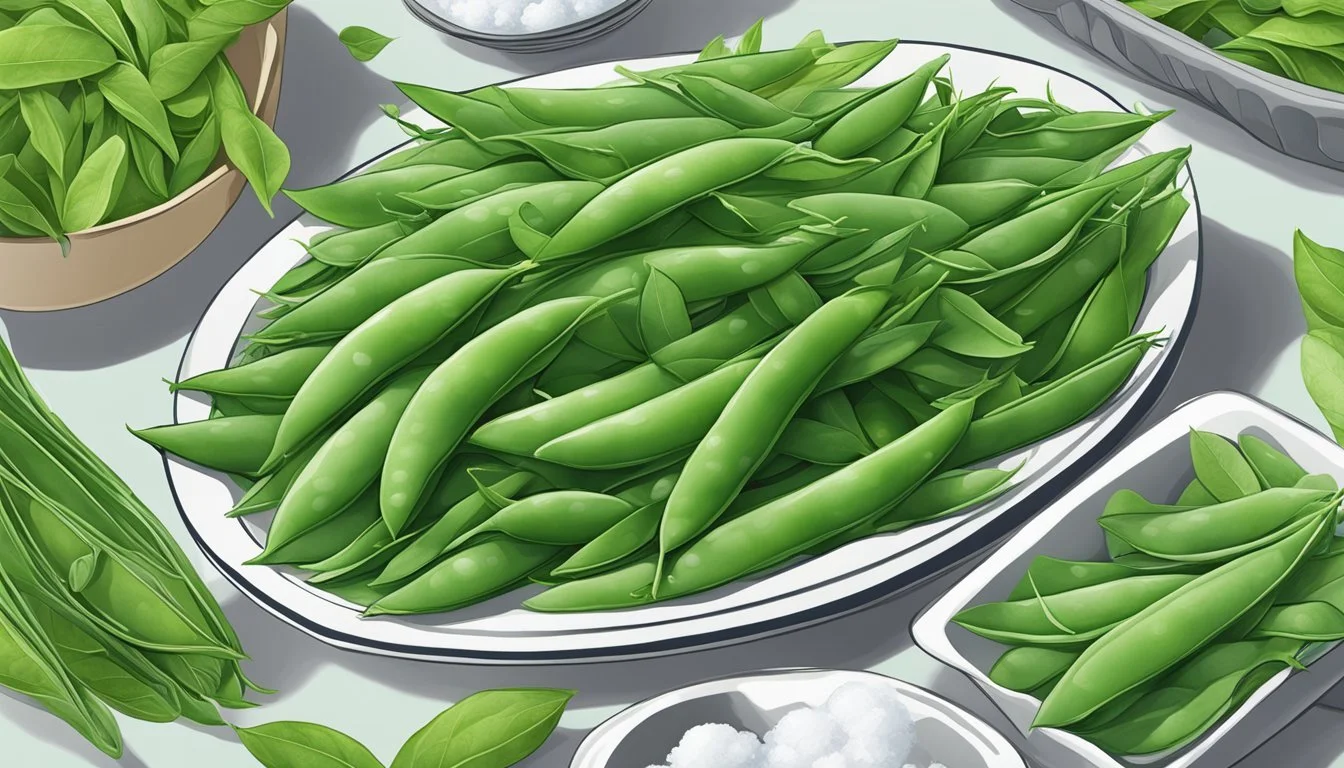Snow Peas Substitutes
Best Alternatives for Your Recipes
Snow peas are a versatile addition to many dishes, but sometimes finding a substitute is necessary when they’re not available. Understanding which alternatives work best can save your recipe. Sugar snap peas are an excellent substitute for snow peas due to their similar crunch and sweet flavor. They can be easily integrated into stir-fries, salads, and soups.
Additionally, cauliflower is another fantastic alternative. Its mild, nutty flavor and crunchy texture when cooked make it a suitable replacement in various recipes, including vegetable roasts, curries, and more.
Edamame also steps in as a green, tasty option. These beans are simple to cook and maintain a satisfying texture that pairs well with or instead of snow peas. Each of these substitutes can ensure that your cooking remains seamless and flavorful.
Understanding Snow Peas
Snow peas, known for their sweet flavor and crunchy texture, are commonly used in various culinary dishes. They provide multiple nutrients and can be enjoyed both raw and cooked.
Characteristics of Snow Peas
Snow peas are a type of pea characterized by their flat, firm, and edible pods. Unlike other pea varieties, snow peas are harvested and eaten while still immature, resulting in their unique flavor and texture.
The pods are usually light green and sometimes slightly translucent, allowing the small peas inside to be visible. The entire pod is edible, making them convenient for quick and easy preparation. Snow peas are sweet and crunchy, whether eaten raw or cooked.
Nutritional Profile
Snow peas are low in calories but rich in essential nutrients. They are an excellent source of fiber, which aids in digestion. These peas provide significant amounts of vitamin C, which supports the immune system, and vitamin K, essential for bone health.
In addition, snow peas contain B vitamins such as folate, which is crucial for cell growth and metabolism. They also offer a good amount of potassium, which helps maintain proper heart and muscle function.
Culinary Uses
Snow peas are incredibly versatile in the kitchen. Their crunchy texture and sweet taste make them a favorite in various dishes. They can be enjoyed both raw and cooked. When raw, they add a refreshing crunch to salads.
In cooked dishes, snow peas shine in stir-fries, where they retain their crispness and flavor. They can also be added to soups, vegetable roasts, and even curries. Snow peas cook quickly, ensuring they maintain their characteristic firmness and sweetness, making them a delightful addition to any meal.
Selecting Substitutes
Choosing a substitute for snow peas involves considering factors such as texture, flavor, and cooking techniques. Below are the key criteria for making a good selection and some recommended substitutes.
Criteria for Choosing Substitutes
Freshness, availability, and compatibility with your dish are vital when selecting substitutes for snow peas. The substitute should mimic the texture and flavor of snow peas to maintain the integrity of the recipe.
Texture is crucial. Snow peas are known for their crispness, so look for alternatives that retain their crunch even when cooked. Flavor is another key aspect; the substitute should have a mild, slightly sweet taste similar to snow peas.
Cooking time also matters. The ideal substitute should cook in a comparable amount of time to snow peas to ensure even cooking of your dish. Consideration of nutrients and color can also influence your choice, aiming for vegetables that provide similar health benefits and visual appeal.
Best Substitutes for Snow Peas
Several vegetables can effectively replace snow peas. Sugar snap peas are an excellent choice, offering a similar sweet flavor and crunchy texture. They can be found in most supermarkets and grocery stores and are versatile in various dishes.
Asparagus is another suitable substitute. Its slightly woody taste and crisp texture make it a good addition to stir-fries and roasted dishes. Asparagus also packs a nutritional punch, providing vitamins and minerals comparable to those in snow peas.
Cauliflower can work well, especially in dishes requiring a mild flavor and firm texture. When chopped into small pieces, cauliflower mimics the crunch of snow peas and works beautifully in soups, salads, and stir-fries.
Alternative Cooking Techniques
Certain substitutes might require different cooking techniques to bring out their best qualities. Edamame beans, for example, are typically boiled or steamed, making them a delightful, bright green addition to various plates. Their texture is firm but tender, offering a different but pleasurable bite.
Baby corn is another option, often used in Asian cuisine. It's best to blanch it before stir-frying to preserve its crunch while eliminating any raw taste.
Cranberry beans may need slightly more preparation. They should be soaked and cooked before adding to dishes, providing a texture similar to snow peas but with a richer, bean-like flavor.
By understanding these subtleties, replacing snow peas can be smooth and satisfying, ensuring your dishes remain delicious and balanced.
Vegetable Alternatives
When snow peas are unavailable, several vegetables can serve as excellent alternatives. Focusing on the texture, sweetness, and versatility of these substitutes can help maintain the intended flavor and appearance of dishes.
Green Beans for Texture
Green beans offer a tender and crisp texture that is similar to snow peas. With a mild flavor, they can be a suitable replacement in stir-fries, salads, and side dishes.
Green beans are often available year-round in supermarkets and Asian markets, making them a convenient option. They can be prepared by steaming, boiling, or sautéing. For optimal texture, it is essential to avoid overcooking them. Green beans retain a bright green color when cooked properly, adding visual appeal to meals.
Sugar Snap Peas for Sweetness
Sugar snap peas are known for their sweet and crunchy characteristics. They can be consumed both raw and cooked, making them versatile for various recipes. The sweetness of sugar snap peas closely mimics that of snow peas, helping to maintain the intended flavor profile of dishes.
These peas are readily available year-round in both fresh and frozen forms. Like snow peas, they require minimal preparation; just wash and trim the ends. Sugar snap peas are ideal for stir-fries, salads, and as a standalone snack. Their bright green color adds visual vibrancy to meals.
Edamame and Peas in Pods
Edamame beans, often found in their pods, provide a nutty flavor and tender texture which works well as a snow pea substitute. Although different in appearance, edamame can enhance vegetable medleys and stir-fries with its unique taste.
Edamame is commonly available in supermarkets and Asian markets, typically sold frozen. Cooking edamame involves boiling or steaming, after which the beans are easily popped out of their pods. Frozen peas can also be used when fresh options are not available. They are versatile in various dishes, from soups to stews, and maintain a mild sweetness similar to snow peas.
Other Substitutes
Finding alternatives to snow peas can add variety to your dishes while providing similar textures and flavors. This section explores a few effective substitutes, focusing on broccoli, cauliflower, asparagus, celery, and legumes. Each option offers a unique taste and can be used in various recipes.
Broccoli and Cauliflower
Broccoli and cauliflower both offer a crunchy texture and mild flavor, making them ideal replacements for snow peas. Broccoli can be used in stir-fries, roasted vegetable dishes, and soups. It provides a slightly bitter taste that complements meats and other vegetables well. Cauliflower has a nutty, almost sweet flavor and crunchy texture when cooked. It works excellently in salads, curries, and even as a side dish. Both vegetables are high in fiber, vitamins, and minerals, offering a nutritious boost to any meal.
Asparagus and Celery
Asparagus is another excellent substitute due to its crunchy texture and subtle, earthy flavor. It can be grilled, steamed, or roasted, making it a versatile option for many dishes. Celery brings a crisp, refreshing crunch and is often used in soups, stews, and as a snack. While celery is less sweet than snow peas, its crispness and ability to absorb flavors make it suitable for various recipes. Using asparagus and celery not only adds different textures but also ensures that your dishes remain healthy and balanced.
Legumes and Beans
Various legumes like green peas and chickpeas can effectively replace snow peas. Green peas offer a sweet flavor and can be steamed, boiled, or sautéed to match the texture of snow peas. They are perfect for salads, pastas, and side dishes. Chickpeas provide a nutty taste and can be roasted or included in soups and stews for added protein and crunch. Legumes in general, including edamame, add a splash of green and pack a nutritional punch, rich in fiber, protein, and essential vitamins. Each legume brings a distinct flavor and can seamlessly fit into a multitude of recipes.
Preparing Substitutes
When preparing substitutes for snow peas, various methods can be employed to ensure the alternatives retain their texture, flavor, and nutritional benefits. We explore different techniques to help you incorporate these substitutes seamlessly into your dishes.
Steaming and Blanching Techniques
Steaming is ideal for substitutes like cauliflower, asparagus, and sugar snap peas. This method helps retain their crunchiness and nutritional content. Place the vegetables in a steamer basket over boiling water, cover, and steam until tender-crisp, usually 3-5 minutes.
Blanching involves briefly boiling the substitutes before plunging them into ice water. This technique is perfect for edamame and crunchy beans. Bring a pot of water to a boil, add the vegetables, and cook for 2-3 minutes. Immediately transfer them to a bowl of ice water to stop cooking, preserving their color and texture.
Sautéing for Extra Flavor
Sautéing adds depth and flavor with the use of olive oil, herbs, and spices. Heat a tablespoon of olive oil in a pan over medium heat. Add substitutes like baby corn, cauliflower florets, or snap peas, and cook until they start to char slightly, usually 5-7 minutes.
For enhanced flavor, incorporate garlic, lemon juice, or thyme. Mix thoroughly to coat the vegetables evenly. This method enhances the chewy texture and brings out a savory taste, making the substitutes more appealing in various dishes.
Raw Preparations
Certain substitutes can be used raw, maintaining their crunchy and fresh qualities. Sugar snap peas and baby corn are excellent eaten raw in salads or as part of a vegetable platter. Ensure that the vegetables are thoroughly washed and, if necessary, strings are removed from edible pod peas.
Asparagus can be thinly sliced and served raw, adding a nutty flavor to salads. Topping these raw varieties with a simple dressing of olive oil, lemon juice, salt, and pepper can enhance their natural taste. This method keeps the textures and flavors intact, providing a fresh alternative to cooked dishes.
Incorporating Substitutes into Dishes
Substituting snow peas in your recipes can add variety and excitement to your meals. This section details how to incorporate them into salads, stir-fries, soups, and main courses effectively.
Salad Creations
Using substitutes like sugar snap peas or snow pea shoots in salads can provide a similar crunch and sweetness. Sugar snap peas can be sliced and added raw to green salads, enhancing texture and flavor.
Cauliflower can also be chopped finely and tossed with leafy greens, nuts, and dressings for a satisfying bite.
Edamame beans bring a splash of color and a hearty texture when boiled and cooled before adding to cold salads. These substitutes maintain the freshness and crispness that snow peas typically offer.
Stir-Fry Innovations
In stir-fries, sugar snap peas and asparagus are excellent alternatives due to their firm texture and ability to absorb flavors. Slice sugar snap peas to match the size and shape of snow peas for consistency in your dish.
Asparagus, cut into bite-sized pieces, adds volume and color to the stir-fry. Cauliflower florets can also be used; their mild flavor pairs well with soy sauce and garlic. Ensure all vegetables are cooked quickly over high heat to retain their crunch.
Soups and Snacks
For soups, using cauliflower or asparagus can add a delightful crunch and flavor. Add these vegetables toward the end of cooking to keep them from becoming too soft.
Edamame works well as a snack or soup addition. Simply boil or steam edamame and season lightly with salt or your favorite spices before adding them to soups or enjoying them as a snack. Sugar snap peas can also be enjoyed as a raw snack or lightly cooked in broths.
Pasta and Main Courses
When it comes to pasta dishes and other main courses, sugar snap peas and asparagus are top choices. Their firm texture and sweetness balance well with various pasta sauces, whether tomato-based or creamy.
Chop asparagus into pieces and sauté briefly before combining with pasta and sauces.
Edamame beans, added to pasta, provide a protein-rich substitute and a pop of green. Cauliflower can be roasted and integrated into casseroles, adding both texture and volume to your meal. These ingredients maintain the structural integrity and complement a wide range of flavors.
Conclusion
When searching for a substitute for snow peas, it is essential to consider options that offer similar taste and texture. Sugar snap peas and snap peas are close alternatives. They have a comparable sweetness and crunch, making them suitable for various dishes.
Garden peas provide another viable substitute. Though not identical in texture, they share a similar flavor profile and can be used in many recipes.
For those looking for something different, asparagus and baby corn can also be excellent choices. Both add a unique flavor and texture while maintaining the dish's integrity.
Another alternative is edamame. These young soybeans are rich in protein and offer a fresh green color, making them a visually appealing addition.
Cauliflower can be an unexpected yet effective substitute. With its mild, nutty flavor and crunchy texture, it can mimic the role of snow peas in recipes like stir-fries and salads.
Summarizing the options:
Snap Peas
Garden Peas
Asparagus
Baby Corn
Edamame
Cauliflower
Choosing the right substitute will depend on the specific dish and personal taste preferences.








